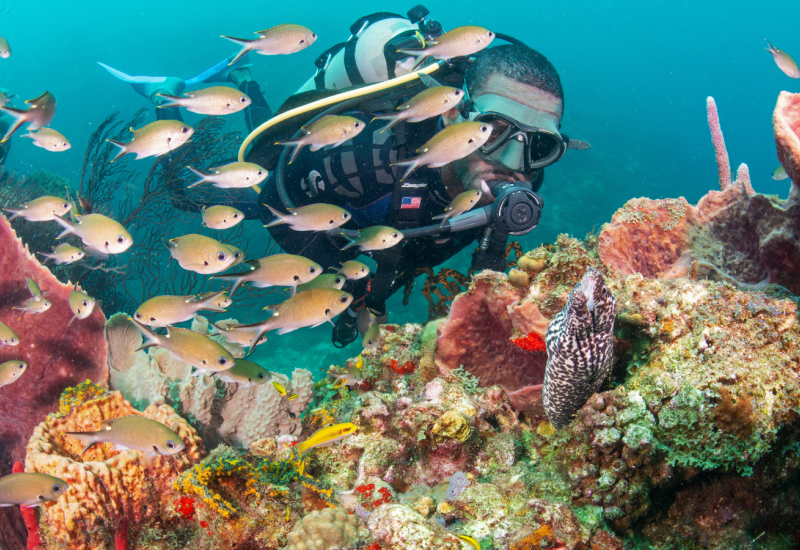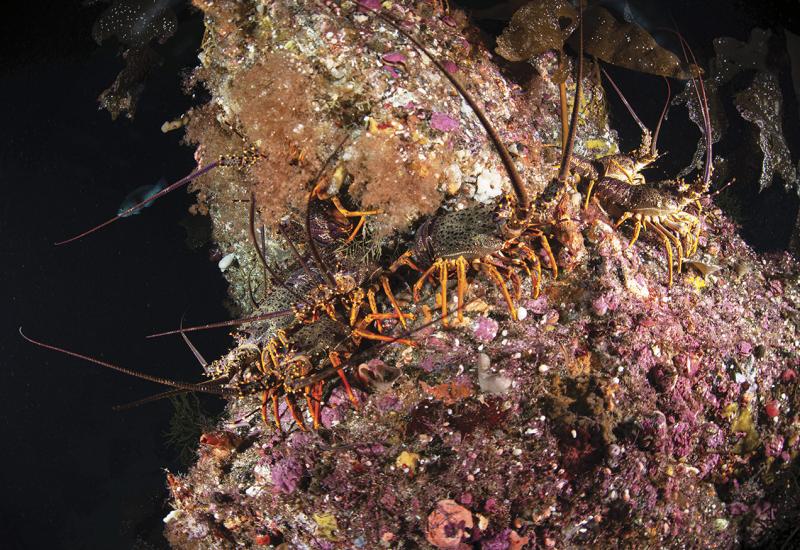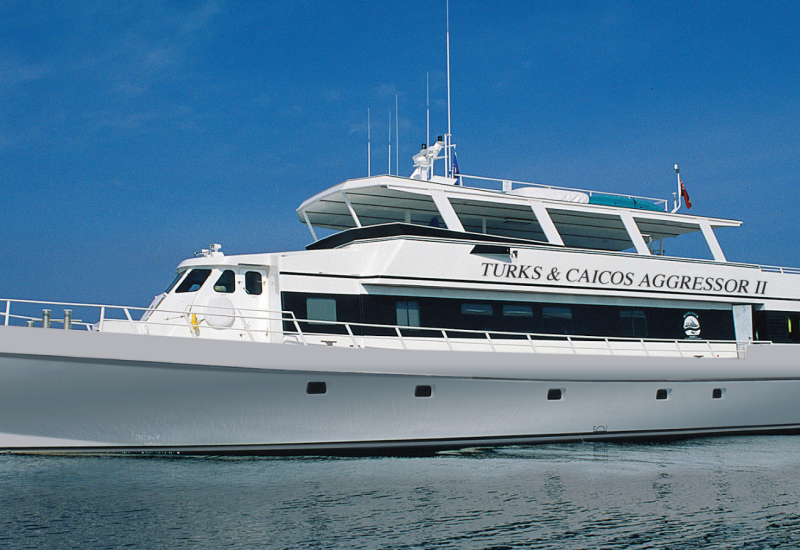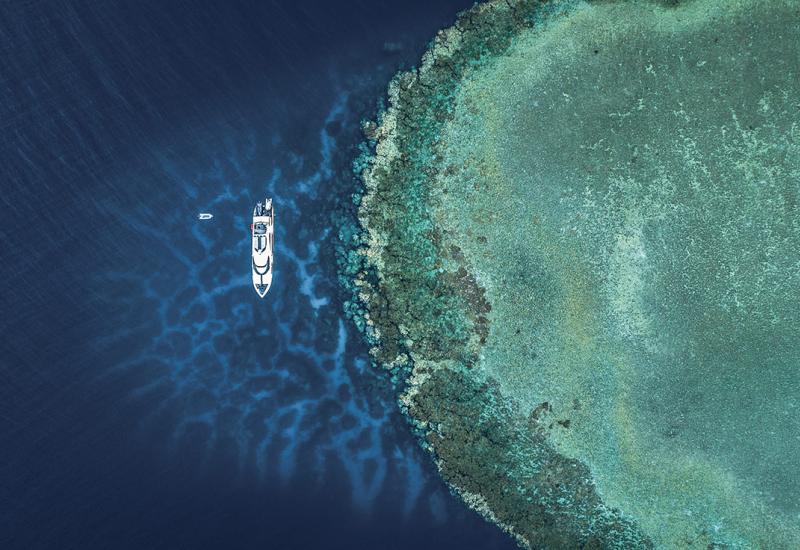Diving Mexico’s Revillagigedo Archipelago

Franco BanfiThis beautiful composite image showcases the beauty of Mexico’s Revillagigedo Archipelago both above and below the surface.
Some things you know are going to be unforgettable from beginning to end: Pulp Fiction, test-driving a Porsche 911, the Rolling Stones in concert. So it is with diving Mexico’s Revillagigedo Archipelago.
It’s possible in a single day — even a single dive — to encounter humpback whales blowing mere yards from the boat, while underwater, giant mantas flap past in acrobatic twirls. Sharks? It depends on the day, but hammerheads, whitetips, silvertips, silkies, threshers, Galapagos and tigers all are possible. In the eastern Pacific waters off this island chain better known to American divers as the Socorros, the action starts the moment you arrive.
Collectively, the island group — Socorro, Roca Partida, San Benedicto and Clarion — is one of the holy grails of adrenaline-seeking divers. They’re reachable only by liveaboard, a 24-hour, often stomach-churning trip from Cabo San Lucas on the southern tip of the Baja California peninsula.
“It is, in my opinion, the most unique and pristine island habitat that remains on Earth,” says Robert Rubin, project leader of the Pacific Manta Research Group, which has been working in the islands for more than three decades.
This summer, the United Nations Educational, Scientific and Cultural Organization — UNESCO — added the whipped-cream topping to this confection of a site by inscribing the islands on its World Heritage Site list.
“We are so very relieved and happy that the declaration has been made to include it as a World Heritage Site,” says PMRG project manager Karey Kumli. “But in this abundant and pristine corner of the world, there are challenges it faces due to human impact. And so, the work begins.”
While UNESCO issues recommendations for safeguarding World Heritage Sites, its enforcement authority does not extend beyond their designation (see A New Management Plan, below)). In other words, say some conservationists, if local governments and conservation agencies don’t establish a management plan with teeth, the designation is little more than a gold-star seal of approval slapped on the location.
The archipelago “sits at a critical ecological crossroads,” says Peter Shadie, senior advisor on world heritage at the International Union for Conservation of Nature. Shadie says the IUCN recommended to inscribe the site, determining “that protection and management were adequate to ensure long-term conservation,” but he notes IUCN also advocates “that the no-take marine zoning be extended to the full extent of the boundaries of the inscribed property.”
The islands sit in the middle of two distinct biogeographic regions, the eastern and northeastern Pacific, and are washed by the California and Equatorial currents. This creates a fecund stew, says Shadie, “for large aggregations of marine species such as sharks, manta rays and whales.”

Franco BanfiSocorro, Roca Partida, San Benedicto and Clarion islands are surrounded by marine like like this manta ray.
The islands are 240 miles southwest of Cabo San Lucas, far from any infrastructure, a blessing and a curse when it comes to protection.
On one hand, says Shadie, “the remoteness of the archipelago should permit controlled management of tourist access, thus ensuring protection.”
But the islands’ isolation makes it difficult to enforce regulations. “Liveaboard dive boats have played a crucial role in deterring illegal commercial fishing boats from entering the waters around the islands,” says David Valencia, a professional underwater photographer who lives and works in Cabo San Lucas. Valencia says liveaboards visit the islands from November to June only. “The Mexican government will have to increase its presence around the islands if it is to truly protect them.”
The threat from increased tourism or other human activity has had an impact on other World Heritage Sites. Hawaii’s Papahanaumokuakea National Monument, for example, is one of five World Heritage Sites listed as threatened by UNESCO. It suffers due to excessive traffic in shipping lanes that cross it.
“A specific recommendation requests the Mexican authorities to carefully manage tourism interest and potential growth [in the Revillagigedos], including specific recommendations concerning diving operations,” says Shadie.
An agency of the United Nations based in Paris, UNESCO’s has a sweeping, high-minded mission: build peace, eradicate poverty, promote sustainable development and secure the world’s cultural and natural heritage. The World Heritage Committee was established in 1976 and the first sites inscribed on the World Heritage List in 1978. The first marine site was listed in 1982.
“Tourism only becomes a problem when it’s not sustainably managed,” says Fanny Douvere, coordinator of UNESCO’s marine program. “It is essential to take steps to keep the [Revillagigedo] archipelago beautiful and well protected. For example, when the government installs a limited number of permanent morning buoys that has a very positive impact.”

Franco BanfiThe sharks of Mexico’s Revillagigedo Archipelago still need protecting, despite its designation as a UNESCO World Heritage Site.
Despite their World Heritage status, marine sites face numerous challenges in addition to tourism pressure, including coral bleaching and unsustainable and illegal fishing. “There are some 50 marine sites from around the world that are inscribed and are truly exceptional places,” says Douvere. “Nations work for years to get World Heritage recognition, but that recognition comes with a responsibility to protect them for future generations. Nations are bound by that responsibility.”
UNESCO regards these sites as “our legacy to humanity,” Douvere says. “We do monitor and oversee the sites. We look at whether governments are protecting them. It is true that there are places that are not very well managed, but we have a lot of places, especially marine places, that are very well managed. It’s important to stress there are some 50 marine sites from around the world, including household names like the Galapagos and Great Barrier Reef, that are inscribed. These are sites for the world to keep its eyes on. It’s an entire collection that we need to keep for the world’s future generations.”
Conservationists like Kumli, Shadie and Valencia know firsthand what’s at stake in the Revillagigedos.
The reefs are teeming with life,” says Valencia. “This is what our oceans must have looked like 100 years ago. These islands are a special place that we should preserve and protect not only for Mexico but for the entire world.”
A New Management Plan
In announcing the World Heritage Site designation for the Revillagigedos, UNESCO also called for additional protection and long-term monitoring to better understand the islands’ critical ecosystem. Among UNESCO’s specific recommendations:
Extend the no-take zone to 12 nautical miles from the islands
Strengthen monitoring and targeted management of alien invasive species
Ensure careful management of tourism in anticipation of future increases in the activities of recreational divers in order mitigate adverse impacts on marine environments and important species such as humpback whales and oceanic manta rays
Install a limited number of permanent mooring buoys










